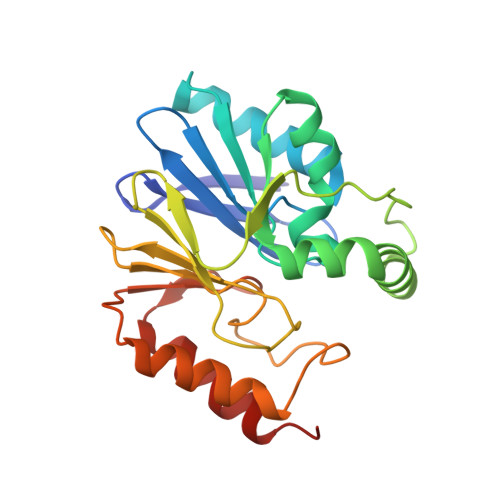The structure of the dizinc subclass B2 metallo-beta-lactamase CphA reveals that the second inhibitory zinc ion binds in the histidine site
Bebrone, C., Delbruck, H., Kupper, M.B., Schlomer, P., Willmann, C., Frere, J.-M., Fischer, R., Galleni, M., Hoffmann, K.M.V.(2009) Antimicrob Agents Chemother 53: 4464-4471
- PubMed: 19651913
- DOI: https://doi.org/10.1128/AAC.00288-09
- Primary Citation of Related Structures:
3F9O, 3FAI - PubMed Abstract:
Bacteria can defend themselves against beta-lactam antibiotics through the expression of class B beta-lactamases, which cleave the beta-lactam amide bond and render the molecule harmless. There are three subclasses of class B beta-lactamases (B1, B2, and B3), all of which require Zn2+ for activity and can bind either one or two zinc ions. Whereas the B1 and B3 metallo-beta-lactamases are most active as dizinc enzymes, subclass B2 enzymes, such as Aeromonas hydrophila CphA, are inhibited by the binding of a second zinc ion. We crystallized A. hydrophila CphA in order to determine the binding site of the inhibitory zinc ion. X-ray data from zinc-saturated crystals allowed us to solve the crystal structures of the dizinc forms of the wild-type enzyme and N220G mutant. The first zinc ion binds in the cysteine site, as previously determined for the monozinc form of the enzyme. The second zinc ion occupies a slightly modified histidine site, where the conserved His118 and His196 residues act as metal ligands. This atypical coordination sphere probably explains the rather high dissociation constant for the second zinc ion compared to those observed with enzymes of subclasses B1 and B3. Inhibition by the second zinc ion results from immobilization of the catalytically important His118 and His196 residues, as well as the folding of the Gly232-Asn233 loop into a position that covers the active site.
Organizational Affiliation:
Centre for Protein Engineering, University of Li¨¨ge, All¨¦e du 6 Ao?t B6, Sart-Tilman, 4000 Li¨¨ge, Belgium. carine.bebrone@ulg.ac.be


















